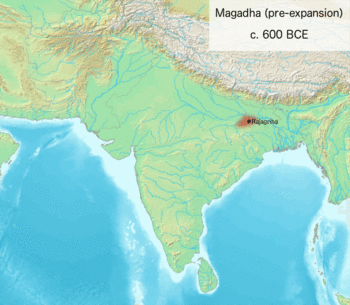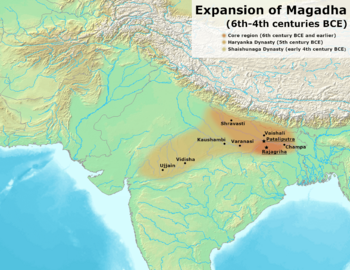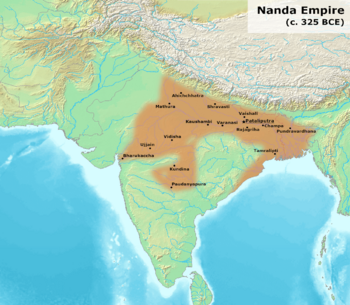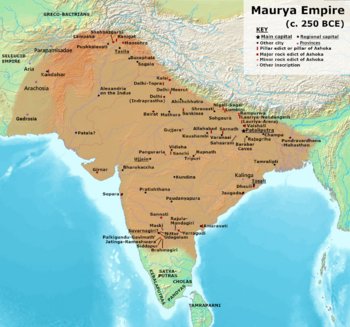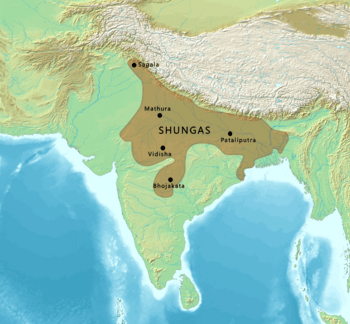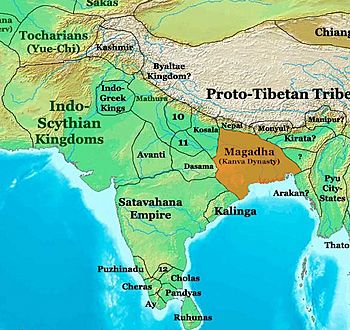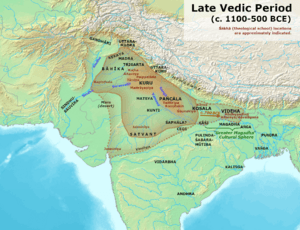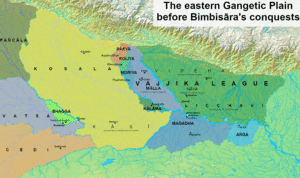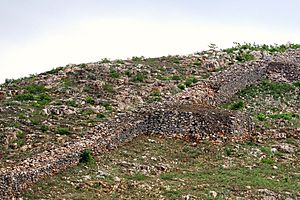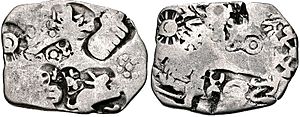Magadha facts for kids
Quick facts for kids
Kingdom of Magadha
Magadha Empire |
|||||||||||||
|---|---|---|---|---|---|---|---|---|---|---|---|---|---|
| 684 BCE – 28 BCE | |||||||||||||
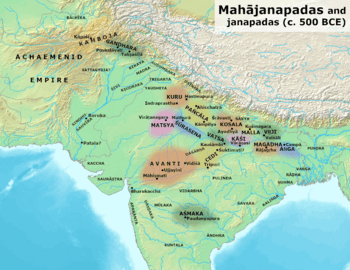
Kingdom of Magadha and other Mahajanapadas during the Second Urbanization.
|
|||||||||||||
|
Territorial expansion of the Magadha empire 6th century BCE onwards
|
|||||||||||||
| Capital | Rajagriha (Girivraj) Later, Pataliputra (modern-day Patna) |
||||||||||||
| Common languages | Sanskrit Magadhi Prakrit Ardhamagadhi Prakrit |
||||||||||||
| Religion | Hinduism Buddhism Jainism |
||||||||||||
| Demonym(s) | Māgadhī | ||||||||||||
| Government | Absolute monarchy | ||||||||||||
| Notable Emperors | |||||||||||||
|
• c. 544 – c. 492 BCE
|
Bimbisara | ||||||||||||
|
• c. 492 – c. 460 BCE
|
Ajatashatru | ||||||||||||
|
• c. 413 – c. 395 BCE
|
Shishunaga | ||||||||||||
| Historical era | Iron Age | ||||||||||||
| Currency | Panas | ||||||||||||
|
|||||||||||||
| Today part of | India | ||||||||||||
Magadha was an important ancient kingdom and empire in Ancient India. It was located in the eastern Ganges Plain, in what is now southern Bihar, India. Magadha was one of the sixteen "Great Kingdoms" during a time known as the Second Urbanization.
This powerful kingdom was ruled by several dynasties over many centuries. These included the Haryanka dynasty, the Shaishunaga dynasty, the Nanda dynasty, the Mauryan dynasty, the Shunga dynasty, and the Kanva dynasty. Under the Mauryas, Magadha grew into a huge empire. It covered a large part of the Indian subcontinent and even parts of Afghanistan.
Magadha was also very important for the development of two major religions: Jainism and Buddhism. It was the heart of several great empires in northern India, including the Nanda Empire, Maurya Empire, Shunga Empire, and Gupta Empire.
Contents
Where Was Magadha?
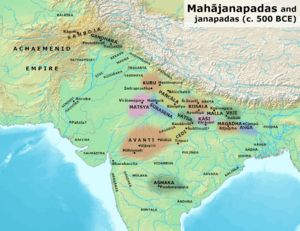
The original Magadha kingdom was surrounded by rivers and mountains. To the north was the Ganges River, to the west the Son River, and to the east the Chandan River. The Vindhya Range mountains formed its southern border. This area is now the Patna and Gaya regions in Bihar, India.
A larger area called "Greater Magadha" included neighboring parts of the eastern Ganges plains. This region had its own unique culture and beliefs. Many important changes happened here around 500 BCE, including the rise of Jainism and Buddhism.
Magadha's Story
The earliest mentions of the Magadha people are found in ancient texts like the Atharvaveda. The kingdom's first capital was Rajagriha (modern Rajgir). Later, the capital moved to Pataliputra (modern Patna). Magadha grew by conquering nearby regions like Anga and the Vajjika League. Eventually, the kingdom included much of modern-day Bihar, Jharkhand, Orissa, West Bengal, eastern Uttar Pradesh, and even parts of Bangladesh and Nepal.
Ancient texts from Jainism, Buddhism, and Hinduism (like the Ramayana and Mahabharata) often mention Magadha.
We don't have much clear information about Magadha's very first rulers. Most of what we know comes from Buddhist, Jain, and Hindu writings. These sources suggest that the Haryanka dynasty ruled Magadha for about 200 years, from around 543 to 413 BCE.
Gautama Buddha, who founded Buddhism, spent much of his life in Magadha. He reached enlightenment in Bodh Gaya. He gave his first sermon in Sarnath. The first major Buddhist meeting was held in Rajgriha.
The Hindu Mahabharata says that Brihadratha was the first ruler of Magadha. Later, the Haryanka dynasty began with King Bimbisara. King Bimbisara was a strong leader who expanded the kingdom. He conquered the Kingdom of Anga. Sadly, his own son, Ajatashatru, killed him.
King Ajatashatru then fought a long war with the Licchavi tribe, who lived north of the Ganges River. He built a fort at Pataliputra to help with his attack. It took him fifteen years to defeat the Licchavis. Jain texts say he used new weapons, like a catapult and a special covered chariot that was like an early tank. After Ajatashatru's death, Pataliputra became the new capital and a busy trade center.
The Haryanka dynasty was replaced by the Shishunaga dynasty. Then, in 345 BCE, Mahapadma Nanda took over, starting the Nanda dynasty. This dynasty was known for having nine kings.
Around 326 BCE, Alexander the Great's army reached the western borders of Magadha. However, his soldiers were tired and scared of facing another huge Indian army. They refused to march further east, so Alexander turned back.
Around 321 BCE, the Nanda Dynasty ended. Chandragupta Maurya defeated the last Nanda king, Dhana Nanda. Chandragupta, with the help of his teacher Chanakya, founded the Maurya Empire. This empire grew to cover most of India under King Ashoka The Great. Ashoka was first known as 'Ashoka the Cruel' but later became a follower of Buddhism and was called 'Dharma Ashoka'. After the Mauryan Empire, other empires like the Shunga Empire came and went. The Gupta Empire later also had its capital in Pataliputra, Magadha.
Buddhism and Jainism in Magadha
Before the 6th century BCE, many different spiritual movements existed in India. These movements, called Śramaṇa, explored various ideas about life and the universe. Magadha was a key place where these new ideas developed.
Jainism was renewed and strengthened by Mahavira. He was the 24th and last Tirthankara (a great teacher in Jainism). Mahavira brought together and revived ancient spiritual traditions. Buddha founded Buddhism, and it received support from the kings of Magadha.
Some historians believe that the culture of Magadha was quite different from the Vedic kingdoms of the Indo-Aryans. In Magadha, warrior classes (Kshatriyas) were sometimes seen as more important than priests (Brahmins). Also, the people of Magadha often did not follow the traditional Vedic rituals or accept the authority of the Vedas (ancient Hindu scriptures).
This "Greater Magadha" region, where the Buddha and Mahavira lived and taught, was a place of new ideas. Vedic texts sometimes described the people of this area as "barbarians" or ritually impure. This shows how different the cultures were. During the early Buddhist period, this new culture was very strong in the eastern Ganges plain.
The religions of Magadha, like Jainism, Buddhism, and Ājīvika, are called sramana traditions. These religions did not worship the traditional Vedic gods. They often practiced asceticism (a simple, strict way of life) and meditation. They also built round burial mounds called stupas (especially in Buddhism). These religions aimed to find freedom from the cycle of rebirth through spiritual understanding.
Important Religious Sites
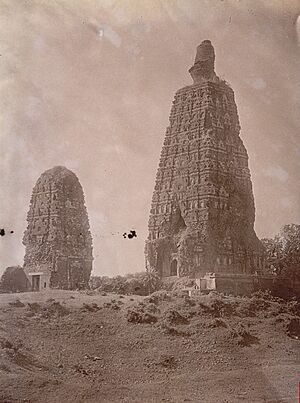
Magadha is home to several important Buddhist sites. Two of these are UNESCO World Heritage Sites: the Mahabodhi temple at Bodh Gaya and the Nalanda monastery. The Mahabodhi temple is a very sacred place for Buddhists. It is believed to be where the Buddha reached enlightenment.
Languages of Magadha
The Pali language, used in many Buddhist texts, was thought to be very similar to Magahi, the language spoken in Magadha. Some scholars believed that Pali was the language Buddha himself used. Pali has some features that are similar to Magahi.
Magadhi Prakrit was one of the main languages that developed after Sanskrit. It was spoken in Magadha and nearby areas. Over time, it changed into modern eastern Indo-Aryan languages like Magahi, Maithili, and Bhojpuri.
Magadha's Rulers
Two famous rulers of Magadha were Bimbisara (also called Shrenika) and his son Ajatashatru (also called Kunika). Both are mentioned in Buddhist and Jain writings as living at the same time as the Buddha and Mahavira. Later, Mahapadma Nanda took over the throne, starting the Nanda Dynasty. This dynasty conquered much of northern India. The Nanda dynasty was then overthrown by Chandragupta Maurya, who founded the Maurya Empire.
It's a bit tricky to know the exact order of kings and dates for Magadha before Mahapadma Nanda. Different ancient texts tell slightly different stories. Historians use a "Long Chronology" and a "Short Chronology" to try and figure out the timeline.
According to historian John Keay, King Bimbisara likely ruled in the late 5th century BCE, and Ajatashatru in the early 4th century BCE. After Ajatashatru, there was a period of confusion with many changes in rulers until Mahapadma Nanda finally secured the throne.
List of Rulers (Long Chronology)
This list follows the Buddhist text Mahavamsa:
- Haryanka dynasty (c. 544 – 413 BCE)
| Ruler | Reign (BCE) |
|---|---|
| Bimbisara | 544–491 BCE |
| Ajatashatru | 491–461 BCE |
| Udayin | 461–428 BCE |
| Anirudha | 428–419 BCE |
| Munda | 419–417 BCE |
| Darshaka | 417–415 BCE |
| Nāgadāsaka | 415–413 BCE |
- Shishunaga dynasty (c. 413 – 345 BCE)
| Ruler | Reign (BCE) |
|---|---|
| Shishunaga | 413–395 BCE |
| Kalashoka | 395–377 BCE |
| Kshemadharman | 377–365 BCE |
| Kshatraujas | 365–355 BCE |
| Nandivardhana | 355–349 BCE |
| Mahanandin | 349–345 BCE |
- Nanda Empire (c. 345 – c. 322 BCE)
| Ruler | Reign (BCE) |
|---|---|
| Mahapadma Nanda | 345–340 BCE |
| Pandhukananda | 340–339 BCE |
| Panghupatinanda | 339–338 BCE |
| Bhutapalananda | 338–337 BCE |
| Rashtrapalananada | 337–336 BCE |
| Govishanakananda | 336–335 BCE |
| Dashasidkhakananda | 335–334 BCE |
| Kaivartananda | 334–333 BCE |
| Karvinathanand | 333–330 BCE |
| Dhana Nanda | 330–322 BCE |
Famous People from Magadha
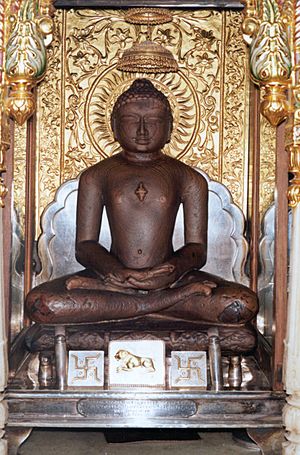
Many important people lived in the ancient region of Magadha:
- Śāriputra – He was born into a wealthy family near Rajagaha in Magadha. He was one of the Buddha's two main male students.
- Maudgalyāyana – Born in a village in Magadha, he was another one of the Buddha's two main students. He traveled a lot before meeting the Buddha.
- Mahavira – He was the 24th and last Tirthankara of Jainism. He was born into a royal family in what is now the Vaishali district of Bihar. At age 30, he gave up all his possessions to become an ascetic (someone who lives a very simple, strict life). He lived around the same time as the Buddha.
- Maitripada – An 11th-century Buddhist teacher known for his wisdom. He was born in a village in Magadha and was connected to the famous Nalanda and Vikramashila monasteries.
See also
 In Spanish: Magadha para niños
In Spanish: Magadha para niños
- Mahajanapadas
- History of India
- Magadha-Vajji war
- Magadha-Anga war
- Avanti-Magadhan Wars
- List of Indian monarchs
- Timeline of Indian history
- Magahi Culture
- Magahi Languages


